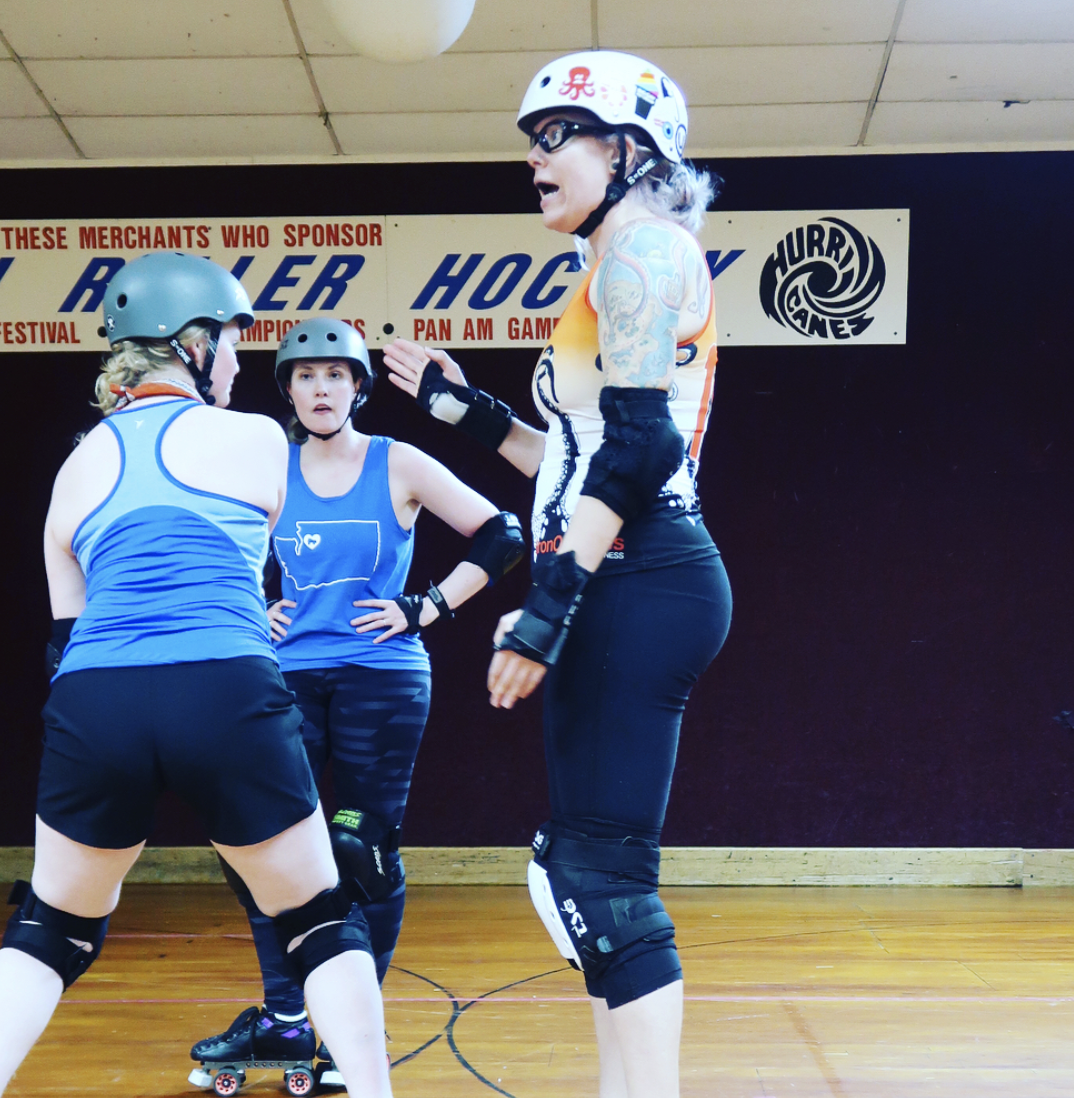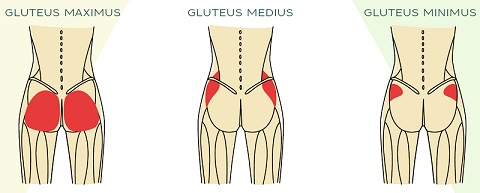
AKA Do More Butt Stuff
People write songs about butts. A good butt is an inspiration. From Sir Mix-a-Lot to Tina Blecher, butts can make the world go-round.
More specifically, as a skater, your butt can make YOU go-round.
That’s why, for 99% of the athletes I meet, I recommend glute work. Not just for the aesthetics, all though those are nice, right? But because your posterior chain muscles should be doing most of the work when you skate. Or run. Or jump.
Your glutes are actually made up of 3 different muscles plus a whole additional slew of non-glute muscles that provide support and stability. The glutes are the drivers of your hips which is the production site for a lot of the power and movement you need to play roller derby.
In other words:
YOU NEED YOUR BUTT TO WORK WELL SO THAT YOU CAN SKATE WELL.
But a lot of folks have developed poor movement patterns when it comes to their butts. For a lot of us, we’ve developed a compensation that means that our glutes do very little and our quads do a whole lot.
- Do your legs fatigue quickly (especially your quads) when you’re doing laps?
- Do you primarily “feel” a squat in your quads?
- Does squatting or long periods in derby form cause knee pain, low back pain, or stiffness?
Then you need to do more butt stuff.
WHAT’S THE DEAL WITH THE GLUTES?

Your glute muscle is actually 3 glute muscles that are in charge of 2 major functional movements at the hip: flexion and abduction.
The gluteus maximus is the largest of the glute muscles (and the one they write songs about). It originates at the back of the bony crest of your hip bone and wraps down and around to attach to the femur. Because of this placement, the gluteus maximus is primarily in charge of hip flexion with some assistance when your leg laterally rotates.
As a superficial muscle (closer to the surface), the gluteus maximus usually only comes into play when force is required. Like in running, climbing, or skating.
The gluteus medius and gluteus minimus get less playtime when it comes to songs, but these glute muscles are often more important when it comes to building strong and stable hip motion. These muscles are both smaller and fan-shaped originating toward the front of the pelvic crest and attaching in the back. The glute medius is slightly larger and sits on top of the glute minimus. Both of these muscles:
- Work to abduct the leg away from the midline.
- Medial rotation of the hip.
- Stabilization of the pelvis during movement.
https://teachmeanatomy.info/lower-limb/muscles/gluteal-region/
What does that mean for your skating?
It means that the main motions that power your around the track whether it’s during laps or when moving laterally are controlled by your glutes.
When you’re skating laps:
- you need to flex at the hip to get your leg moving back behind you.
- you need to abduct to push out to the side.
- you need medially rotate to get that extra little flick from the front inside wheel of your skate.
All these motions are primary movements of the glutes. If you’re using your quads to power through your skating, they’re going to be sore in the morning and you won’t be executing as effectively.
When you’re moving laterally:
- you need to medially rotate if you want to use heel leading lateral glides.
- you need to laterally rotate if you want to use toe leading lateral glides.
- you need to be able to power out of your glute to quickly change direction as both a jammer and a blocker.
This is one of the reasons why derby butt is an actual real phenomenon. For a lot of us, it’s the first time in a long time that those muscles have been asked to do what they’re built for. And the more you learn to engage them and the more you work on strengthening them, the better they’ll do that job.
There a lot of other little muscles in there holding your hips together, aiding with stability, and participating in hip and leg movement. But these are the main glute muscles
LEARNING TO ENGAGE YOUR GLUTES
As I alluded to early, learning to engage your glutes can actually be pretty difficult. Yes, they are big muscles. Yes, they do a lot of jobs. But they are also very likely to let other muscles to those jobs instead and essentially take a free ride. (Seriously. Gluteal amnesia is a literal phrase that folks in the fitness industry use.)
Some of this is from the way our society is set-up. It’s not the most glute-friendly when it comes to using your butt muscles. A lot of us sit all day or have altered our movement patterns to allow other muscles to take over. And even if we work on these muscles in the gym and use them frequently during skating, they still might need a little bit of a wake-up to get them going.
Here’s a quick pre-practice or pre-training day warm-up that will target all 3 of your glute muscles — and all those little stabilizers, too — so that they are thoroughly woken up and ready to do the job once you lace up your skates:
The “Wake-Up Your Glutes” Warm-Up
- Prone Lengthening x 8-10
Not a strictly GLUTE based exercise but, trust me, you need to learn how to breathe better, too. This rhythm of breathing is also great to take to practices, scrimmages, and bouts for when you start to stress out.
- IT Band Roll (2 mins per leg)
- Glute Roll (2 mins per side)
THEN, REPEAT THE FOLLOWING CIRCUIT 2 TIMES:
- Shin Box x 10 per side
If switching back and forth is too hard, simply do all the lifts on one side then switch and do all the lifts on the other. Incorporating the switches helps with hip mobility, but can feel awkward at first. Do your best.
- Banded Clamshells x 10 per side
Put your hips up against a wall to keep them from shifting back and compensating for your butt muscles. The distance that you can open your leg doesn’t matter that much as long as you are squeezing through your glute muscle. Literally, put your hand there to feel it contract as you work. Start without a band, if needed.
- Side-Lying Leg Lifts x 10 per side
Same as above. Keep the toe of your working leg pointing toward the ground so that you are leading with your heel. TOUCH YOUR BUTT.
- Single-Leg Hip Bridge Hold x 10-15 secs
Keep your hips level as though you could rest a tray across them without spilling anything off one side or the other. Your lower back should stay flat, don’t arch through it to get your hips higher into the air. TOUCH YOUR BUTT.
Spending time waking up your glutes before lower body training days (and, yes, even before practice) is a big part of getting them to do the job they are supposed to do. Instead of being lazy freeloaders, as glutes tend to do.
You may find that adding this warm-up before you put your skates on immediately makes you feel more stable at the beginning of practice. Don’t say that I didn’t warn you…
PRIME’S FAVORITE BUTT EXERCISES
Of course, I’d be remiss if I didn’t also share with you some of the exercises that I put in my actual training to not just turn my glutes ON, but make them bigger, stronger, more stable, and better at doing what I want them to do when I’m skating. (Or hiking. Or walking down the street.)
Hip Thrusts
Hip Thrusts are one of my go-to exercises for heavy glute isolation work. They may look super awkward but when you do them properly, your butt muscles are going to light up. It’s wildly important to put the work in the glutes here. That means squeezing those muscles together tight at the top and avoiding that arch in your lower back. It helps to think of your pelvis as a bowl of soup and you’re trying to pour the soup toward your belly button. It’s also imperative to have a double-chin here by pulling your head back and keeping your neck neutral. This position also makes the awkward eye contact you’ll make with gym bros all the sweeter.
While this particular exercise does mainly target your gluteus maximus, you can recruit your other glute muscles by putting a resistance band around your thighs just above your knees.
Glute Bridges
Kind of like a hip thrust, but without the bench! I like glute bridges for warm-ups or high volume work (12-15 reps or higher) and there are so many amazing variations that will work not just your glutes but also the other hip stabilizers and hamstrings.
- Banded Glute Bridge
- Single-Leg Glute Bridge
- Feet Elevated Glute Bridge (can also be done single-leg)
- Psoas Focused Single-Leg Glute Bridge
Hip Abductions
Not one, not two, but three ways to do hip abduction!
You might be thinking to yourself, “Prime, can I just use the machine?” SURE. But there are reasons why I love the banded hip abduction more than the use of machines. First, the band requires you to stabilize yourself. There’s not a machine to do it for you. Second, the band increases resistance as you get out to your full glute contraction which makes it work harder. Third, it’s easier to change your upper body positioning (by hinging at the hips) so that you can target different parts of your glutes.
Lean forward, sit upright, or lean back and hit your glutes in lots of different ways. (In fact, I challenge you to do them all in one workout and see what you think.)
Romanian Deadlifts
While not strictly a glute exercise (we’re starting to hit those hammies!), I love the Romanian deadlift as a way to teach the hip hinge upright. You’ve already been doing it in your hip thrusts and glute bridges but taking it to standing can be challenging. If getting to heavy conventional deadlift is on your goals list, then you have to start by figuring out how to get your glutes — and hamstrings — to control the movement. That’s why I love these.
It’s critical that you focus on that first move being a PUSH BACK at the hips rather than a quad dominated knee bend. Keep the weight light and film your form until you start to get it down.
Hamstring Curls
Okay, okay. Yes. Now we’re almost fully into hamstring territory. But if your glutes are working well, then we need to start getting your hamstrings involved, too. The stability ball is great here because it still recruits those glute and hip muscles into doing their stabilizing jobs. As long as you can keep your body in a straight line as you curl the ball to your butt, you’ll feel it in the backs of those legs.
Now you know. Do more butt stuff.
Want More?
If you’re interested in more exclusive content, access to my FREE resource library, and the slightly weird workings of my inner mind, you can sign up for the Iron Octopus Fitness email list HERE. Wherein I harass you weekly with all things intelligent cross training, mindset, and…other.

![Training Ideas for When You’ve Hit That SLUMP [Part 3]](https://ironoctopusfitness.com/wp-content/uploads/2017/04/level-up-training-image-1.jpeg)